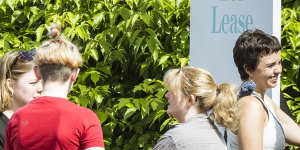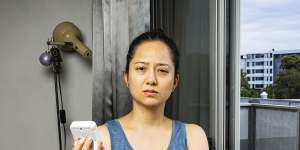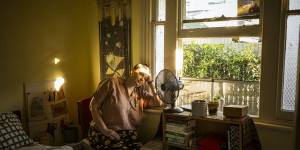Tenants sweltered through a hot summer,with a rental crisis and the cost of living leaving some unable to afford to run air-conditioning,or worried about asking their landlord for improvements for fear of eviction,research from advocacy group Better Renting has found.

There are few homes available for rent.Chris Hopkins
Health professionals and community groups have spoken out in support of strengthening minimum standards for rentals to include insulation and cooling,to alleviate heat-related illnesses.
In Sydney,Marrickville renter Andrea Leong was among 123 tenants who tracked temperatures and humidity in her home with a smart thermo-hygrometer from early December to late February as part of Better Renting’s reportCruel Summers:Renters’ diverse experiences of Summer 23-24. Fourteen participants withdrew during the study,leaving 109 in total. Her home peaked at 31 degrees and 75 per cent relative humidity.
The heat affects her sleep and flares up her dyshidrotic eczema,which blisters her hands and feet. The heat also makes it uncomfortable to have guests over.
“The minimum across the whole period was 24.5 degrees ... and the humidity usually sits around 60 per cent,” the microbiologist said.

Andrea Leong tracked the temperature and humidity in her Marrickville rental home.Ben Symons
“Even though we knew it was hot,it was shocking to confirm that it doesn’t really get much below 25 degrees,even at night.”
That’s despite keeping heavy curtains drawn on hot days,having double-glazed windows in the bedroom and a split system air-conditioner in the living room,which she considers herself lucky to have – along with a landlord who does repairs when needed and takes their responsibilities seriously.
Leong had previously stood for election with the Science Party and the Fusion Party but is no longer active in those parties.
In Melbourne,Richmond renter Madeline Cooper said the city’s most recent heatwave in the second week of March made her bedroom unusable for three days.
“The hottest it got in my bedroom was 31.9 degrees. The maximum humidity in this room has been up to 93 per cent,and the humidity is sitting at 63 per cent right now. So it also gets damp,” she said.
Cooper’s landlord recently installed an efficient air-conditioner in her living room,but the home’s poor insulation meant its effect was muted. Cooper,whose long COVID symptoms were exacerbated by extreme temperatures,said she felt the rental crisis made finding a new,better home prohibitively difficult.
“I can’t really afford this place,and I can’t afford to move. And finding a cooler,better-insulated rental in this market is basically impossible,” she said. “Renters have to put up with what we have.”
Better Renting director Joel Dignam said indoor temperatures higher than 25 degrees were cause for concern,because of the effect it had on sleep and other health conditions.

Madeline Cooper has long COVID and finds the extreme summer temperatures in her rental home make it hard to manage her illness and work.Chris Hopkins
The renter researchers found this summer that their homes were above 25 degrees for 52 per cent of the time in NSW,20 per cent of the time in Victoria,87 per cent of the time in Queensland and 67 per cent of the time in WA.
“The overall picture across Australia is that it’s been pretty grim,and this was a hotter summer than the last two summers,which is reflected in the data,” he said. “Overnight you’re well past the healthy threshold for sleep at that point. Ideally,you’d have a home sitting around 21 degrees. But at 25 degrees,you’re out of that comfort zone.
“We find renters are spending a lot of time out of that comfort zone.”
Renters often said their home felt hotter inside than outside,so the study compared how often the outside temperature was greater than 21 degrees and the indoor temperature was even higher.
Of the period when it was more than 21 degrees outside,it was hotter inside than out for 13.5 per cent of that time in Victoria,42.5 per cent in NSW,37.4 per cent in WA and 63.6 per cent in Queensland.
Some participants in the study also said they were struggling with the cost of living,which affected their willingness to run an air-conditioner. They worried about making trouble with their property manager,struggled to sleep,or wanted to move but found the alternatives were too expensive. One with heat-related health issues was forced to call an ambulance when their symptoms escalated;another,in the past,had to sleep in a tent in the yard as a better alternative to their hot home.
The report recommends minimum energy performance standards for rental homes,and improving the power of renters to exercise their rights.
Sweltering Cities executive director Emma Bacon recently spearheaded an open letter addressed to the Victorian government,which was signed by more than 50 doctors,housing and health organisations and called for the adoption of insulation and cooling minimum rental standards.
“What we are doing with doctors,health experts and housing advocates around the state is making it clear to the government that there are health impacts to not[considering] cooling in the minimum standards.
“Doctors are hearing from patients that they’re getting sick because of the homes they’re living in. The Victorian government could reduce the health burden on the community by making this simple update,” she said. “If Victoria is the first state to put cooling in the minimum standards,we would hope the rest would follow.”
Leong would like to see minimum energy performance standards introduced for rental properties,and better design outcomes for new buildings.
“Having a healthy home shouldn’t be a matter of striking it lucky. Everyone should have a safe home,” she said.
Real Estate Institute of Australia president Leanne Pilkington said housing standards would improve as states and territories updated minimum standards. She encouraged landlords to speak to their property managers to understand their obligations and how to best improve the energy efficiency of their investment properties.
“It’s more of a focus now than ever before. The summers are getting warmer and I just opened my electricity bill and it’s $400 more than the last,” she said. “Everything is getting more expensive,including electricity. It’s much more top of mind than it was 12 months ago.”